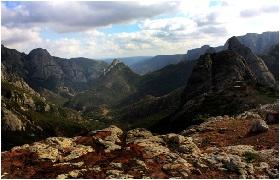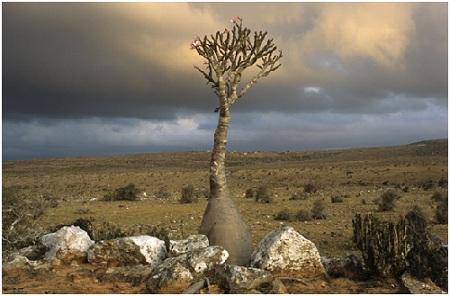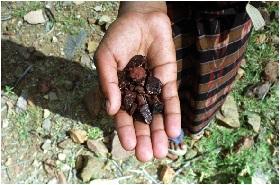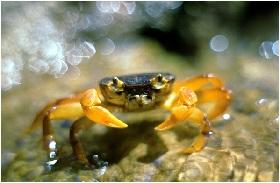Using AI to control energy for indoor agriculture
30 September 2024
Published online 25 May 2011
Who can protect Yemen's invaluable natural treasures during times of political upheaval and change?

The Socotra Archipelago south of Yemen is one of only four United Nations Educational, Scientific and Cultural Organization (UNESCO) Natural World Heritage Sites in the Arab world. This group of small islands in the Western Indian Ocean formed from land that detached from the continental Arabian Peninsula about 20 million years ago, and the group of four isolated islands is now home to some of the world's most bizarre life forms. The characteristic swollen-trunked bottle trees of Socotra are striking examples, such as the cucumber tree (Dendrosycios socotrana) or the Socotra fig (Dorstenia gigas).
Since being declared a World Heritage Site in 2008, Socotra has changed. The changes are quick and multifaceted, from the political to the cultural and environmental. When UNESCO evaluates the Socotra site status in 2012, Yemen should have undergone political reform as a result of the current uprisings and the rapidly changing political landscape.
On 22 March 2011, the Yemeni minister of water and environment, Abdulrahman Fadhl Al-Eryani, announced his resignation by email. Al-Eryani has been an enthusiastic and strong advocate for the involvement of the international scientific community in Socotra's conservation. He was a major driving force behind the island's UNESCO designations as a Man and Biosphere reserve in 2003 and later as a World Heritage Site in 2008.
The speed with which events unfold in the Middle East has taken everyone by surprise. While international visitors to Yemen have been evacuated and the country is temporarily shut to the outside world, there is no contingency plan to tackle environmental issues on the islands during these trying times. Yet Yemen harbours globally important natural treasures, on which local communities depend, and which are now under threat.
Socotra's biodiversity is like an ancient book of beautiful, precious texts, of which only one copy remains, but is fragile to the softest touch. A book with regional and even global importance.

As the largest and oldest island of Arabia, the main island of Socotra is as significant to the region as the Galapagos archipelago is to South America and Madagascar is to Africa. Socotra is ancient, distant and diverse — the same applies to its species. In fact, it is the only continental island that has retained some animal and plant species that derived from ancient biota once common to southern Arabia (until the Miocene epoch, when Socotra broke away). The long-extinct ancestors of these 'palaeo-endemics' have disappeared from the mainland. The geological history of Socotra, with its 700 million years old granite base, spans a much longer period than in the Galapagos where, according to recent studies, dry volcanic land has been present for about 3 million years1. In contrast to most islands, which are oceanic and young, such an old insular biodiversity is exceptional. This resulted in a mixed biota with ancient continental relicts, taxa that evolved in situ and some more recent newcomers.
Socotra's endemism is highly concentrated – botanists have shown that only Hawaii and New Caledonia in the Pacific Ocean, and the Seychelles in the Indian Ocean, surpass Socotra in the number of endemic plants per square kilometer. Such an ancient evolutionary record with rare genotypes is invaluable and cannot be expressed in monetary value. How much money is the fauna of the Galapagos worth, which inspired Darwin to formulate his theory of natural selection, a pillar of modern scientific thinking? Biodiversity is priceless and we can barely grasp its potential.
The study of evolution on islands has changed our understanding of life. Studying evolutionary processes like insular speciation is just one example of the vast scientific importance of islands. For example, we are now able to include a time dimension in examining the diversification events of species using molecular methods. Geological events, like the separation of an island, may give us a time frame for when endemic life started to evolve in situ. Although a fledgling field of science, 'molecular clock' approaches are giving insight into modes of speciation and the evolution of complete groups of plants and animals.
The implications of biodiversity and ecosystems reach far beyond science. Several of Socotra's endemic plant species contain unique chemicals with medicinal properties, well known to local people. For example, phytochemical studies of the Dragon's Blood Tree in Socotra have shown its antioxidant and antibacterial properties and have lead to the discovery of several flavonoids unique to this species, like damalachawin and cinnabarone. Traditional herbal medicine is actively practiced by the Socotrans, travelling from one generation to the next to make up a vast ethnobotanical knowledge. Besides the scientific uses, we should not forget that local people depend on biodiversity for their livelihoods. What we know for sure is that island biodiversity is vulnerable. And when a species or an ecosystem is gone, all of its potential use is lost to us forever.

Kay Van Damme
How long a species has been around is no guarantee of its resilience against one of the younger, more invasive species on the planet: humans. We are witnesses and instigators of a global biodiversity crisis, the first human-mediated mass extinction in the planet's history, which the renowned American paleontologist Niles Eldredge refers to as the 'sixth extinction'. The human impact on Socotra's ecosystems remained relatively low until a few decades ago, in comparison to many other islands of the world. For example, Socotra has lost none of its unique terrestrial bird, reptile or mollusk species in the last century2.
The island is not invulnerable, however. Researchers from international institutes such as Ghent University, Belgium, the Royal Botanical Garden Edinburgh, United Kingdom, Birdlife International and Senkenberg Research Institute, Germany, closely interact with local authorities on biodiversity and conservation issues. Recently, two such researchers, Lisa Banfield and myself, combined botanical and zoological experience on the island and examined the contemporary issues of terrestrial biodiversity in Socotra in a historical context2.
Challenges are relatively new but quickly spreading. They include well-known causes for global insular biodiversity loss (including habitat fragmentation, over-exploitation and loss of traditional knowledge). Tourism has increased exponentially over the past decade and is concentrated in the few months at the end of the year when tourists converge on the most sensitive protected areas of the island. In 2010, the Socotra Tourism Office officially recorded 3,788 foreign visitors, of which 95% were tourists (Socotra Governance and Biodiversity Project, UNDP, pers. comm.).
The situation parallels that of the Galapagos in the early 1970s, where tourism boomed but was ultimately held responsible as one of the major underlying causes for local ecosystem decline 30-40 years later2. Facing a looming wave of extinction, the biodiversity of Socotra is at stake. The time to act is now — not in 20 or 30 years, when extinctions will have caused unforeseen cascade effects in the weakened ecosystems. On an island, people and the environment are more closely connected than on continents and changes in the ecosystems can irreversibly affect the local inhabitants in the long term.
When biologists talk about biodiversity and stability, they mostly refer to the effects of biological changes and diversity on the functioning of ecosystems. But what is the effect of political instability on biodiversity? Major causes of biodiversity loss are often political, not biological3. New challenges arise with increased instability in the region. The Middle East is changing — and fast. How can we ensure the protection of biodiversity in a rapidly changing world?
Will Socotra become another textbook example of how adept we are at losing insular biodiversity?
Conservation depends on long-term strategies and the commitment of international funding, and is therefore affected by institutional changes. Funding agencies base their assessments of projects on incremental reasoning, making it unattractive to commit funding with little chance of success in the long term. In times of crisis, natural and cultural heritage suffer collateral damage4.
Malek Abdulaziz, manager of the Socotra Conservation and Development Coordination Unit, notes that "in the short term, scientific monitoring programs on Socotra are temporarily discontinued, resulting in a gap in data. It is too early to understand the long-term effects of the current, sudden period of uncertainty." Change in the region, however, can be embraced. In the long run, the process of democratization, causing paradigm shifts in conservation3 and in science, can have a positive effect on biodiversity.
Conservation efforts themselves are often not democratic and might benefit from change. Environmental protection is often controlled by small groups of individuals imposing theory, using unrealistic mathematical models for decision-making and usually failing in practice. After a project ends and millions of dollars are spent, project leaders move on and little has changed on the ground. In fact, structures might have been put in place that collapse as soon as the project ends, impacting local species more than before.
The number of international projects related to biodiversity has increased on Socotra since its nomination as a World Heritage Site. Yet the coordination between them is often inefficient, or even competitive. The results are often of no benefit to biodiversity or to local communities. The true in situ conservation potential lies with the largest group of people closest to the action, the local communities and indigenous populations. Leave local people out of the equation, and conservation becomes less effective. If we want long-term strategies for biodiversity protection on Socotra, their continued participation and traditional knowledge should be a priority. If not, protection could become gradually more dictatorial and even neo-colonialist, ultimately at the cost of conservation credibility and of the biodiversity itself.

Will Socotra become another textbook example of how adept we are at losing insular biodiversity? We have reached a delicate tipping point between a rapid decline of Socotra's biodiversity or its survival. Political upheavals in Yemen will initiate changes in decision-making on long-term policies and determine future strategies. The decisions of today will affect Yemen's biodiversity for decades to come. It is not too late to turn the tide and to aim for strategies that can slow down potential biodiversity loss. Such strategies would include a continued protection of ecosystems and aim at countering trends that clearly indicate increased exploitation or habitat destruction. For example, outlining ways to limit tourism increase or impacts, tackling the import of exotic species and stimulating projects that focus on key species- or habitat-based protection and local community involvement.
The options for the future contain either a stronger expansion of trade, tourism and infrastructure, or a strong emphasis on the environmental and cultural protection and education. The former option, unsustainable development, will inevitably lead to heightened threats to the island's ecosystems and a loss of biodiversity. A third option is trying to maintain a delicate balance between them, though that is hard to maintain. Initiatives that aim to reconcile development and conservation by protecting natural resources, like the exploration of renewable energy, waste management, combating soil erosion, assessing local impacts of climate change or the control of invasive alien species, provide hope for the future.
Whatever future direction environmental protection in the region might take, I hope that continuous efforts for the unique natural heritage of the largest island of Arabia, will help it to survive the current challenges to its biodiversity.
Kay Van Damme, a hydrobiologist at Ghent University in Belgium, has extensively explored the freshwater and cave ecosystems of Socotra, and is passionate about all aspects of the islands' present and past.
doi:10.1038/nmiddleeast.2011.61
Stay connected: